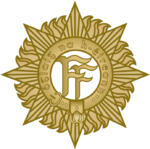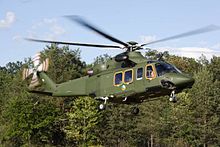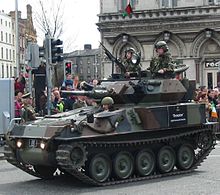- Defence Forces (Ireland)
-
Defence Forces
Óglaigh na hÉireann
Founded 1 October 1924 Service branches Army Air Corps
Army Reserve
Headquarters Dublin Leadership Supreme commander Michael D Higgins (President of Ireland) Minister for Defence Alan Shatter Chief of staff Lieutenant General Sean McCann[1] Manpower Military age 17-24 (27 Naval Service) Active personnel 9,981[2] Reserve personnel 12,348[3] Expenditures Budget FY 2008 - ranked 59th
Euro €1.27 billion (FY00/08)Percent of GDP 0.7% (FY00/07)  Óglaigh na hÉireann - An Irish officer's cap badge.
Óglaigh na hÉireann - An Irish officer's cap badge.
The armed forces of Ireland, known as the Defence Forces (Irish: Óglaigh na hÉireann[4]) encompass the Army, Naval Service, Air Corps and Reserve Defence Force.
The current Supreme Commander of the Irish Defence forces is His Excellency Michael D Higgins in his role as President of Ireland.[5] All Irish Defence Force officers hold their commission from the President, however in practice the Minister for Defence acts on the President's behalf and reports to the Government of Ireland. The Minister for Defence is advised by the Council of Defence on the business of the Department of Defence.[6]
Contents
Role
Ireland's favourable geographical location, on the north-west border of the European Union, makes any external threat or future invasion unlikely. The state has a long-standing policy of non-belligerence in armed conflicts that included neutrality in World War II. For these reasons, the Republic's military capabilities are relatively modest. However, the state has a long history of involvement in United Nations Peacekeeping operations. Functions of the Defence Forces include:
- Preparation for the defence of the state against armed attack.
- Assisting the Garda Síochána (police force), including the protection of the internal security of the state.
- Peace-keeping, crisis management and humanitarian relief operations in support of the United Nations.
- Policing the fisheries, in accordance with the state's obligations under European Union agreements.
- Miscellaneous civil contingency duties requested by the Government such as search and rescue, air ambulance provision, providing secure air transport for ministers, assistance in the event of natural and other disasters, ensuring the maintenance of essential services, and assisting in dealing with oil pollution at sea.
History
See also: History of the Irish ArmyThe Irish Defence Forces trace their origins to the Irish Volunteers founded in 1913. The Defence Forces official title, Óglaigh na hÉireann, is taken from the official Irish language title of the Irish Volunteers. The Defence Forces cap-badge, and the buttons that are worn on Service Dress no.1 uniforms are also from the Irish Volunteers.[6] The Defence Forces buttons still have the letters I V (Irish Volunteers) on them. Volunteers led by Patrick Pearse, took part in the 1916 Easter Rising.
After the rising the Volunteers gave allegiance to the First Dáil. At this time the Volunteers became known as the Irish Republican Army (IRA). The IRA waged a guerrilla campaign against British rule in Ireland between 1919 and 1921.
A Truce brought hostilities to an end on 11 July 1921 and the Anglo-Irish Treaty was signed on 6 December. The Provisional Government was then constituted on 14 January 1922. Many IRA men who fought in the War of Independence were dissatisfied with the Treaty and both Civil War or reoccupation by the British were possible.[6] In February 1922, the Provisional Government began to recruit volunteers into the new Irish National Army. The Irish Civil War began on the 28 June 1922 between the Republican Anti-treaty IRA and the newly-recruited pro-treaty National Army. The Civil War ended on 24 May 1923, Frank Aiken IRA Chief of Staff ordered IRA volunteers to dump arms and the new Irish Free State slipped into an uneasy peace.[6]
On 3 August 1923 the new state passed the "Defence Forces (Temporary Provisions) Act", raising "an armed force to be called Oglaigh na hEireann (hereinafter referred to as the Forces) consisting of such number of officers, non-commissioned officers, and men as may from time to time be provided by the Oireachtas."[7] The establishment of the Forces was on 1 October 1924.[6]
The state was officially neutral during World War II, but declared an official state of emergency on 2 September 1939 and the Army was mobilised. As the Emergency progressed, more and newer equipment was purchased from Britain and the United States. For the duration of the Emergency, Ireland, while formally neutral, tacitly supported the Allies in several ways.[8] German military personnel were interned in the Curragh along with the belligerent powers' servicemen, whereas Allied airmen and sailors who crashed in Ireland were very often repatriated, usually by secretly moving them across the border to Northern Ireland.[8] G2, the Army's intelligence section, played a vital role in the detection and arrest of German spies, such as Hermann Görtz.
Ireland became a member of the United Nations in 1955. The first contribution to peacekeeping was in 1958 when Army officers were assigned to the United Nations Observer Group in Lebanon (UNOGIL). Since 1958 the Defence Forces have had a continuous presence on peace support operations. The first armed peacekeeping mission was to the Operation des Nations Unies au Congo (ONUC) in 1960. The Defence Forces have been continuously on armed UN missions - except between May 1974 to May 1978 but did retain overseas unarmed observer mission during this period. In October 2009, a memorial to Irish personnel who served as United Nations peacekeepers was unveiled in the town of Fermoy. It records that there was a total of ninety Irish fatalities while on active service with the UN until that date.[9]
Organisation
The Defence Forces consist of a Permanent Defence Force (PDF) which is a standing force and provides the main capability for military operations, and a Reserve Defence Force (RDF)[10] which provides the military capability to back up the PDF, when necessary. The RDF is consist of the First Line Reserve and a Second Line Reserve. The First Line Reserve comprises former members of the Permanent Defence Force and the Second Line Reserve comprises an Army Reserve and a Naval Service Reserve.[6]
The Defence Forces are organised into three service branches: Army, Naval Service, and Air Corps.
Army
Main article: Irish ArmyThe Irish Army has 8,500 active personnel,[11] and 13,000 in the Army Reserve. The country is divided into three areas for administrative and operational reasons, and in each area there is an Infantry brigade.
In addition to the Brigades Structure, there is also a Defence Forces Training Centre (DFTC), a Logistic Base in the Curragh and a number of special establishments such as the Equitation School, Army Bands, and the Army Ranger Wing. In the case of Corps which support the Infantry, a Corps Director and staff are provided to coordinate the purchase of specialised equipment, the execution of specialised training, etc. The three brigade group structure envisages distinct operational areas of responsibility for each of the brigades. The First Brigade has primary responsibility for operational tasks in South, the Second for operational tasks in the East and the Fourth Brigade for operational tasks in the West. Practical operational considerations dictate the requirement to outline operational areas of responsibility. The brigade group structure is based on strengthened combat and combat support elements and streamlined combat service support elements.
The Army has nine specialist Corps, each designated as either combat, combat support or combat service support. These are the Infantry Corps, Artillery Corps, Cavalry Corps, Engineer Corps, Ordnance Corps, Medical Corps, Transport Corps, Military Police Corps, Communication and Information Services Corps.
Irish infantry are equipped with assault rifles, machine guns, grenade launchers, hand grenades, and anti-tank weapons. Most weapons used by their defence forces follow NATO standards, and are purchased from abroad, with the Ireland having a very limited arms industry. The Irish Army has light armoured vehicles, with the primary vehicle being the MOWAG Piranha, armed with machine guns. The Irish Army also use the FV101 Scorpion armoured reconnaissance vehicle, equipped with a 76mm low velocity gun and a 7.62mm machine gun. Its artillery capabilities consist of 120mm mortars, 105mm howitzers, 81mm mortars, and 60mm mortars.
Air Corps
Main article: Air Corps (Ireland) Irish Air Corps AgustaWestland AW139 helicopter
Irish Air Corps AgustaWestland AW139 helicopter
The Irish Air Corps is the air component of the Defence Forces. The Air Corps HQ is at Casement (Baldonnel) Aerodrome. The Air Corps is the smallest of the branches of the Defence Forces, with approximately 939 personnel, and its primary roles are defined as:
- Support of the Army
- Support of the Naval Service
- Aid to the Civil Power
There are two secondary roles:
- Aid to Civil Community
- Aid to Government departments
The Air Corps is not officially tasked with the traditional air force role of defending Irish airspace. This was removed from its remit, as has SAR (search and rescue) which is carried out by the Irish Coast Guard.
The Air Corps' two CASA CN-235 maritime patrol aircraft[12] are equipped with detection systems and assist the Naval Service in patrolling Irish territorial waters and EEZ. These aircraft are also used for HALO (High-Altitude, Low-Opening) parachuting by the elite Army Ranger Wing. In addition, the Irish Air Corps has 6 AgustaWestland AW139 transport helicopters sometimes armed with machine guns, 7 Pilatus PC-9 turboprop aircraft equipped with rocket pods and machine guns, 2 Eurocopter EC135 utility helicopters and a number of auxiliary aircraft.
Main article: Irish Naval Service Irish Naval Service vessel LÉ Eithne
Irish Naval Service vessel LÉ Eithne
The Naval Service maintains a complement of about 1,144 personnel, and is tasked with policing Irish territorial waters as well as the Irish Conservation Box a large area of sea in which fishing is restricted in order to preserve numbers. The Naval Service is tasked with enforcing this EU protected area and thus serves the EU as well as Ireland.[13] The Naval Service, together with the Air Corps and Customs, have intercepted a number of vessels carrying narcotics to and from Ireland.[14]
The Navy has eight offshore patrol vessels which are operated in support of the service's main roles, inflatable sea going craft, and training vessels. The Naval Service maintains highly trained armed boarding parties that can seize a vessel if necessary, and a special unit of frogmen called the Naval Service Diving Section. While the Naval Service does not have any heavy warships, all of the naval vessels have enough firepower to enforce their policing roles.
The primary role is defined as "National Security", with secondary roles which include:[13]
- Fishery Protection
- Aid to the Civil Power
- Drug Interdiction
- Maritime Safety
- Diving Operations
- Pollution Control
- Overseas Mission Support
Representative Associations
The interests of members of the Defence Forces are represented by a number of representative associations similar to trade unions.
Commissioned Officers of the Permanent Defence Forces are represented by RACO [15]
Rank-and-file members of the Permanent Defence Forces are represented by the Permanent Defence Force Other Ranks Representative Association (PDFORRA). PDFORRA is affiliated to the Irish Conference of Professional and Service Associations (ICPSA) and to the European Organisation of Military Associations (EUROMIL). In 2009, members of PDFORRA took part in the Irish Congress of Trade Unions (ICTU) protest against the government's handling of the 2008–09 financial crisis. The Department of Defence warned that Defence Forces members could not take part in or sponsor any "public agitation", and that PDFORRA had "no express permission" for members to take part in the protests.[16]
All ranks of the Reserve Defence Forces are represented by RDFRA.[17]
Bases
The Defence Forces operate a number of bases throughout the Republic of Ireland:
 Members of the Army Ranger Wing in a Ford F350 SRV mounted with a Browning M2 HMG
Members of the Army Ranger Wing in a Ford F350 SRV mounted with a Browning M2 HMG
Name Location Defence Forces Headquarters (DFHQ, and Coláiste Caoimhín) Dublin Aiken Barracks Dundalk Casement Aerodrome Baldonnel Cathal Brugha Barracks Rathmines Collins Barracks Cork Columb Barracks Mullingar Coolmoney Camp Glen of Imaal Custume Barracks Athlone Curragh Camp Curragh Dún Úi Mhaolíosa Galway Dún Úi Neill Cavan Finner Camp Ballyshannon Gormanstown Camp Gormanstown Haulbowline Naval Base Cork Harbour Kickham Barracks Clonmel Kilbride Camp Kilbride, County Wicklow Lynch Camp Kilworth McKee Barracks Dublin Sarsfield Barracks Limerick St Bricín's Military Hospital Dublin Stephen’s Barracks Kilkenny See also
- Politics of the Republic of Ireland
- History of Ireland
- The Emergency
- Irish Veterans
- List of countries by military expenditures
- Irish Army deafness claims – a series of 17,000 personal injury claims taken by members of the Irish Defence Forces.
External links
Footnotes
- ^ Holland, Kitty (05-05-2011). "Centre honouring executed pacifists opens". irishtimes.com. http://www.irishtimes.com/newspaper/breaking/2011/0505/breaking47.html. Retrieved 27 May 2011.
- ^ Irish Times - Numbers in Defence Forces hit 40-year low - November 25, 2009
- ^ Military.ie - RDF Homepage - Establishment
- ^ This Irish-language name is not a literal translation, and derives its origins from the Irish Volunteers. A literal translation of Defence Forces of Ireland that is attested in some Irish-language literature is Fórsaí Cosanta na hÉireann.
- ^ President.ie - Official website of the President of Ireland - Office of the President
- ^ a b c d e f The Defence Forces
- ^ DEFENCE FORCES (TEMPORARY PROVISIONS) ACT, 1923
- ^ a b Fanning, R., 1983, Independent Ireland, Dublin: Helicon, Ltd.., pp 124-5
- ^ English, Eoin. "Memorial honours Irish soldiers who died on UN duty Read more: http://www.irishexaminer.com/ireland/memorial-honours-irish-soldiers-who-died-on-un-duty-103128.html#ixzz1Gu5kD55G". Irish Examiner. http://www.irishexaminer.com/ireland/memorial-honours-irish-soldiers-who-died-on-un-duty-103128.html. Retrieved 17 March 2011.
- ^ http://www.military.ie/dfhq/overview/organisation/org.htm
- ^ Military.ie - Army homepage
- ^ The two maritime patrol aircraft are CASA CN-235; see the table at Air Corps (Ireland)#Aircraft for more information.
- ^
- "Department of Defence - Drug Seizures". http://www.kildarestreet.com/wrans/?id=2010-06-02.1113.0.
- Juno McEnroe. "Navy tracking system to crack down on drugs smuggling". Irish Examiner. http://www.irishexaminer.com/ireland/navy-tracking-system-to-crack-down-on-drugs-smuggling-127354.html.
- "Drug Offences". Citizen's Information Board. http://www.citizensinformation.ie/en/justice/criminal_law/criminal_offences/drug_offences.html.
- ^ http://www.raco.ie/
- ^ "Talks under way to avert strikes". The Sunday Business Post. 2009-02-22. http://www.sbpost.ie/post/pages/p/story.aspx-qqqt=IRELAND-qqqm=news-qqqid=39783-qqqx=1.asp. Retrieved 2009-02-23.
- ^ http://www.rdfra.ie/Structure/Scope.shtml
Defence Forces of Ireland Army | Naval Service | Air Corps
Army Reserve | Naval Service Reserve
Militaries of the member states of the European Union Military of Europe Sovereign
states- Albania
- Andorra
- Armenia
- Austria
- Azerbaijan
- Belarus
- Belgium
- Bosnia and Herzegovina
- Bulgaria
- Croatia
- Cyprus
- Czech Republic
- Denmark
- Estonia
- Finland
- France
- Georgia
- Germany
- Greece
- Hungary
- Iceland
- Ireland
- Italy
- Kazakhstan
- Latvia
- Liechtenstein
- Lithuania
- Luxembourg
- Macedonia
- Malta
- Moldova
- Monaco
- Montenegro
- Netherlands
- Norway
- Poland
- Portugal
- Romania
- Russia
- San Marino
- Serbia
- Slovakia
- Slovenia
- Spain
- Sweden
- Switzerland
- Turkey
- Ukraine
- United Kingdom
- Vatican City
States with limited
recognition- Abkhazia
- Kosovo
- Nagorno-Karabakh
- Northern Cyprus
- South Ossetia
- Transnistria
Other entities - European Union
- Sovereign Military Order of Malta
Categories:- Military of the Republic of Ireland
Wikimedia Foundation. 2010.


